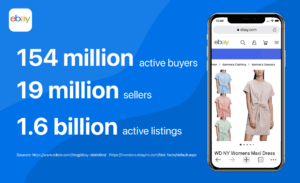About eBay

Source: Google
eBay is a multinational e-commerce company situated in San Jose, California, U.S.A. It was started in the year 1995 by Pierre Omidyar. It deals with consumer-to-consumer and business-to-consumer transactions through its online services. The company has a brand value of around 60 billion dollars. It operates in about 180 countries, as of 2021.
The company’s website provides services like an online auction and shopping for people and businesses all around the world. The business model of ebay is a fascinating one. The company doesn’t charge its buyers to use the website, but they charge the sellers for the listing of their products after their limited free listings are over.
Ultimately eBay’s business plan is to empower people and create economic opportunity for all. Key milestones include its IPO in 1998, the acquisition of PayPal in 2002 (later spun off), and its ongoing innovations in the e-commerce space
In this article, through eBay’s case study you will get to learn the ins-and -outs of the company. We’ll delve into its business model, learn digital marketing strategies of the company and the factors contributing to its global dominance.
eBay Business Model: Updated Statistics
- Annual Active Buyers: 183 million as of Q1 2023 (eBay Quarterly Report, 2023).
- Gross Merchandise Volume (GMV): $90.2 billion in 2022 (eBay Annual Report, 2023).
- Revenue: Generated $10.4 billion in 2022 (eBay Annual Report, 2023).
- Listings: Over 1.7 billion live listings at any given time (eBay Statistics, 2023).
Business Model of eBay

Source: Google
It is important for every business to have its business plans updated regularly. This helps the company to move along with the trends and see the possible challenges ahead. The business model of eBay consists of 11 key units which are as follows:
1. eBay Business Model: Market Share & Analysis
eBay holds a significant share in the global e-commerce market, particularly in the online auction and consumer-to-consumer sales segments. It competes with platforms like Amazon, Alibaba, and Etsy. Despite intense competition, the business model of ebay has been able to manage and maintain a strong presence due to its unique auction model and wide range of product categories. Market analysis shows steady growth, driven by increased online shopping and international expansion.
2. eBay Business Model: Product Offerings

Source: Google
The company offers a vast array of products across various categories, including electronics, fashion, home goods, collectibles, and more. eBay India’s online shopping experience is divided into two parts – auction-style listings and fixed-price listings, catering to different buying and selling preferences. Additionally, eBay Motors focuses on vehicles and parts, while eBay’s Global Shipping Programme simplifies international sales. This business model of eBay helps the company offer diverse products providing a versatile platform for buyers and sellers alike.
3. eBay Business Model: Target Audience

Source: Google
eBay caters to a diverse user base, ranging from individual consumers and small businesses to large corporations. The business model of eBay is structured in such a way that it appeals to a wide demographic, which include casual shoppers looking for bargains to collectors seeking rare items. The platform is popular among tech-savvy users aged 25-54, with a growing user base in emerging markets like India and Southeast Asia.
4. eBay Case Study: Funding & Investors
eBay received its initial funding from founder Pierre Omidyar and later secured significant venture capital investments. The company went public in 1998, raising $63 million in its IPO. Today, eBay’s operations are funded through its powerful revenue streams and strategic investments in technology and acquisitions.
5. eBay Case Study: Revenue Model
eBay’s revenue model generates its takings through several key channels. Sellers on eBay pay transaction fees based on the final sale price of their items, once they exceed the monthly allowance of 50 free listings. The fees charged by eBay vary based on the product type. Additionally, eBay’s revenue model also ensures that it earns from other advertising services that help sellers market their products more effectively.
Another significant source of income is through managed payments, where eBay charges processing fees for transactions, which can involve credit card or PayPal transfers, with a fee of 2.9% for debit or credit card transactions. eBay also takes a commission of 10% on the final sale price for items listed, up to a maximum fee of $250 per item. These revenue streams collectively support eBay’s operations and continue to fuel its growth as a leading online marketplace.
Furthermore, eBay actively combats online predators through dedicated specialists, information sharing with law enforcement, and ongoing technological advancements. All of which is a big part of when it comes to pursuing a digital marketing course online.
6. eBay Case Study: Marketing Strategy

Source: Google
eBay’s marketing strategy focuses on digital advertising, social media, and partnerships. It leverages data analytics to personalise user experiences and improve ad targeting. eBay also engages in affiliate marketing, influencer partnerships, and seasonal promotions to attract new users and retain existing ones. This multi-channel approach ensures broad visibility and user engagement.
The best ads aren’t just seen – they’re interacted with. By showing you relevant ads, eBay’s business model keeps you engaged with the platform, benefiting both, you (interesting content) and advertisers (reaching the right audience). Interested in mastering the art of targeted advertising? Consider diving into a PG in digital marketing programme.. These programmes equip you with the skills to not only understand but also implement such strategies, setting you up for success in the dynamic world of digital marketing.
This strategy of connecting buyers and sellers online has been a big reason for eBay’s business model success. It allows them to offer a wider range of services, reach a larger audience, and keep everyone happy. Want to learn how to master these strategic moves? Check out our free digital marketing certification course. It’s your ticket to understanding how businesses like eBay dominate the market.
7. eBay Case Study: Value Proposition
eBay’s value proposition lies in its vast product selection, competitive pricing, and trusted platform for secure transactions. For sellers, eBay offers a global marketplace with extensive reach and robust tools for managing sales. Buyers benefit from a diverse range of products, user reviews, and buyer protection policies, enhancing their shopping experience.
Value proposition for buyers
- It has brought a variety of community features for the buyers.
- They also provide them with new deals and fashion vault programmes.
- It provides the customers with a wide range of products from different buyers.
- It also provides it with a facility to compare the different products with different sellers.
Value proposition for sellers
- It provides sellers with a large audience all over the world.
- It helps the sellers to find buyers who are interested in out-of-season items or vintage items.
- They are provided with an efficient and economic way to process all the buyer’s payments.
8. eBay Case Study: Operational Model
eBay operates through a network of regional marketplaces, supported by advanced technology infrastructure. Its operational model includes data centres, AI-driven search algorithms, and a robust payment processing system. eBay’s logistics partnerships facilitate smooth shipping and delivery, while its customer support ensures user satisfaction and trust. eBay’s customer service number is available on the website 24/7 which makes it easy for customers to reach out to them at any given point in time.
9. eBay Case Study: Strategic Alliances & Partnerships

Source: Google
eBay has formed strategic alliances with various companies to enhance its services and expand its market reach. Key partnerships include logistics providers like FedEx and DHL, payment processors, and technology firms. These alliances help eBay improve its operational efficiency and offer value-added services to users.
Every successful business, whether it’s a multinational corporation or a small startup, revolves around understanding its target market. Various Companies spend significant resources identifying and catering to specific consumer groups. To learn more about how these companies successfully define and target their audience, consider exploring our digital marketing case studies.
If you need a starting point? Start by first looking into the business model of Nike and the marketing strategy of Uniqlo. Understanding their product offerings, pricing strategies, distribution channels, and promotional tactics can provide valuable insights into effective audience targeting.
10. Business Model Of eBay: Technological Innovations
eBay continually invests in technological innovations to enhance its platform. This includes advancements in AI for personalised recommendations, machine learning for fraud detection, and blockchain for secure transactions. eBay’s use of augmented reality (AR) and virtual reality (VR) aims to improve the shopping experience and attract tech-savvy users.
11. eBay Case Study: Corporate Social Responsibility (CSR)
eBay’s CSR initiatives focus on sustainability, community support, and economic empowerment. Programmes like eBay for Charity enable users to support their favourite causes, while initiatives to reduce carbon footprint and promote responsible commerce reflect its commitment to social responsibility. eBay also supports small businesses through grants and resources, fostering economic growth.
Top Competitors
- Amazon: Dominates the e-commerce market with a vast product selection, fast delivery, and a strong brand reputation.
- Alibaba: A leading player in the global e-commerce market, particularly in Asia, offering a wide range of products and services.
- Etsy: Specialises in handmade and vintage items, attracting a niche market of buyers and sellers.
- Rakuten: A major e-commerce platform in Japan, expanding its global presence through strategic acquisitions and partnerships.
- Walmart: Competes with eBay through its online marketplace and extensive retail network, offering a broad product range and competitive pricing.














